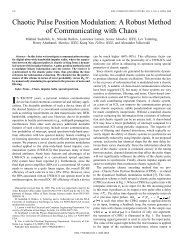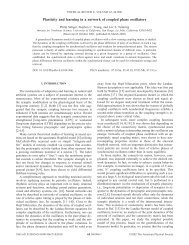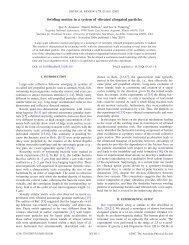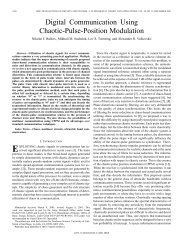A fast, robust and tunable synthetic gene oscillator - The BioCircuits ...
A fast, robust and tunable synthetic gene oscillator - The BioCircuits ...
A fast, robust and tunable synthetic gene oscillator - The BioCircuits ...
You also want an ePaper? Increase the reach of your titles
YUMPU automatically turns print PDFs into web optimized ePapers that Google loves.
doi: 10.1038/nature07389 SUPPLEMENTARY INFORMATION<br />
A<br />
B<br />
1200<br />
Fluorescence<br />
(AU)<br />
Fluorescence<br />
(AU)<br />
200<br />
0 60 120<br />
Time (min)<br />
180<br />
15<br />
6<br />
0 60 120<br />
Time (min)<br />
180<br />
Supplementary Figure 5: Single-cell fluorescence trajectories for A, MG1655Z1/pZE12-yemGFP-ssrA<br />
cells expressing LacI constitutively <strong>and</strong> containing neither positive or negative feedback loops (induced with<br />
2 mM IPTG), or B, JS013 cells containing the negative feedback <strong>oscillator</strong> (induced with 0.6 mM IPTG).<br />
Fluorescence measurements are given in arbitrary units that are consistent between the two experiments<br />
shown. Trajectories are smoothed with a Savitsky-Golay filter. Note that the cells without feedback are<br />
much brighter <strong>and</strong> do not show periodic fluorescence dynamics.<br />
3.5 h at 37 ◦ C. Samples were washed with PBS by centrifugation, <strong>and</strong> flow cytometry analysis<br />
was performed. Our expectation was that, given a circuit that produced oscillating cellular<br />
fluorescence levels, some of the cells in an unsynchronized population would have fluorescence<br />
levels intermediate to bright <strong>and</strong> dim levels. In contrast, a monostable circuit would result in a<br />
well-defined unimodal distribution <strong>and</strong> a bistable circuit would result in a bimodal distribution<br />
with few intermediate cells. A survey of inducer space using this method revealed potentially<br />
<strong>oscillator</strong>y regions that we subsequently investigated in greater detail using flow cytometry <strong>and</strong><br />
microscopy (Supplementary Figs. 6–7).<br />
Additional flow cytometry was performed by one of two similar protocols. <strong>The</strong> temperaturedependence<br />
experiments followed a continuous timecourse flow cytometry protocol, in which a<br />
single culture was induced at the initial timepoint <strong>and</strong> samples were removed for flow cytometry<br />
analysis over the course of the experiment. An overnight culture of JS011 was diluted in growth<br />
www.nature.com/nature<br />
9<br />
240







